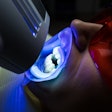
A new systematic review and meta-analysis that evaluated scientific literature for the effectiveness of using splint therapy to treat patients with temporomandibular disorders (TMDs) has found promising results for the treatment but highlights the need for larger trials (Journal of the American Dental Association, August 2012, Vol. 143:8, pp. 847-857).
Several strategies are used for the management of TMDs including exercise, pharmacological interventions, acupuncture, intra-articular injections with anesthetics or corticosteroids, psychological interventions, surgery, and splint therapy, noted the study authors.
However, splint therapy is the most frequently used treatment for TMDs by both general practitioners and dental specialists, study author Shanil Ebrahim, a doctoral candidate at the department of clinical epidemiology and biostatistics at McMaster University, told DrBicuspid.com.
“Dentists ... must be skeptical on how large of an effect they can see from splint therapy.”
— Shanil Ebrahim
In fact, a 1995 study estimated that approximately 3 million splints were made per year in the U.S. at a cost of approximately $990 million (JADA, February 1995, Vol. 126:2, pp. 248-254).
Ebrahim and his colleagues therefore conducted the review to evaluate whether splint therapy is more effective than minimal or no treatment in patients with TMD.
Previous systematic reviews on the topic were based on a summary of a few randomized, controlled trials, which suggested that the use of splint therapy may be beneficial for reducing pain in patients with TMDs, but these studies had "considerable limitations," according to Ebrahim. So the group chose to conduct a systematic review and meta-analysis of published randomized, controlled trials to better determine the true effectiveness of splint therapy.
"This review of randomized, controlled trials consisting of 455 patients is the most comprehensive and rigorous systematic review on the topic to date," said Ebrahim. "It provides readers with a summary of how strong the effect of splint therapy is and also how confident we can be about that effect."
Larger trials needed
Ebrahim and his co-authors searched Medline, Embase, and the Cochrane Central Register of Controlled Trials for studies published from inception of each database through August 2011. Eligible studies included ones where investigators enrolled adult patients with TMDs and assigned them randomly to splint therapy or a control group receiving minimal or no treatment.
Eligible disorders included craniomandibular dysfunction, myofascial pain dysfunction syndrome localized to the jaw, myofascial pain localized to the jaw, and mandibular dysfunction. Splint therapy was classified as any of the following: stabilization splint, Michigan splint, Tanner appliance, Fox appliance, centric relation appliance, soft appliance, or anterior repositioning appliance.
They started with 1,567 potentially eligible studies and retrieved the full text of 70 articles. Fifty-five articles did not meet inclusion criteria and four articles were unavailable. Ebrahim and his colleagues eventually included 11 in the final review.
Moderate-quality evidence suggests splint therapy can reduce pain, while low to very low quality of evidence showed no significant differences between the splint therapy and control groups in terms of quality of life or depression, according to the authors. None of the trial reports described effect on function.
Although overall results are promising for the reduction of pain, establishing the role of splints for patients with TMDs will require large trials with stronger safeguards against bias, they wrote.
Previous results from systematic reviews showed a significant effect of splint therapy, but the authors expected that the small trials and lack of rigor in performing the trial design were biasing this effect.
"We were not surprised by the modest to moderate effect that we found," Ebrahim said. "Dentists continually use splint therapy for treating TMDs, but given our findings from combining the estimates from all trials, they must be skeptical of how large of an effect they can see from splint therapy. Our review suggests that there is some effect, but it is not as large as some dentists may have anticipated."
Given the significant amount of funds allocated to splint therapy annually, the limitations in confidence in estimates of pain reduction, and the uncertainty regarding the effect on function and other aspects of well-being, further research is required to confirm the role of splint therapy in patients with TMDs, the study authors concluded.



















